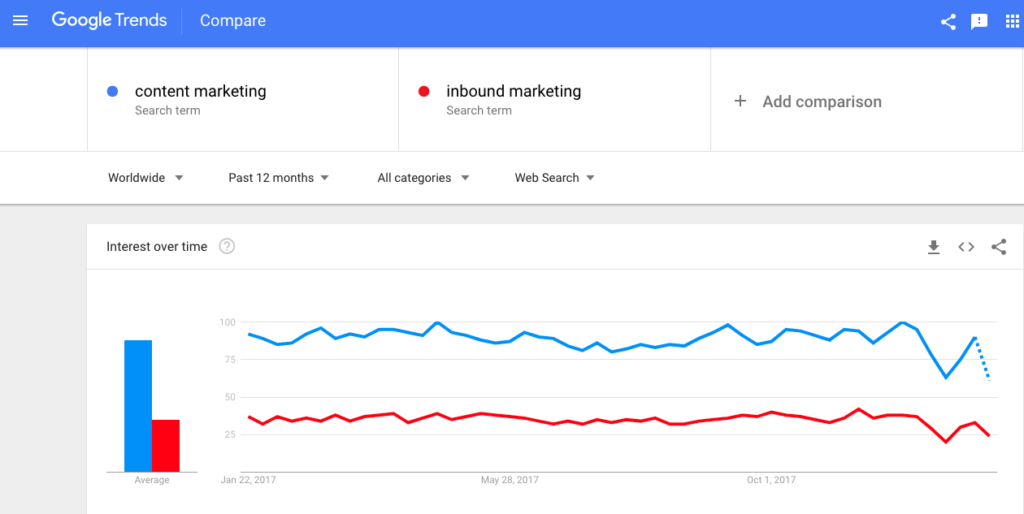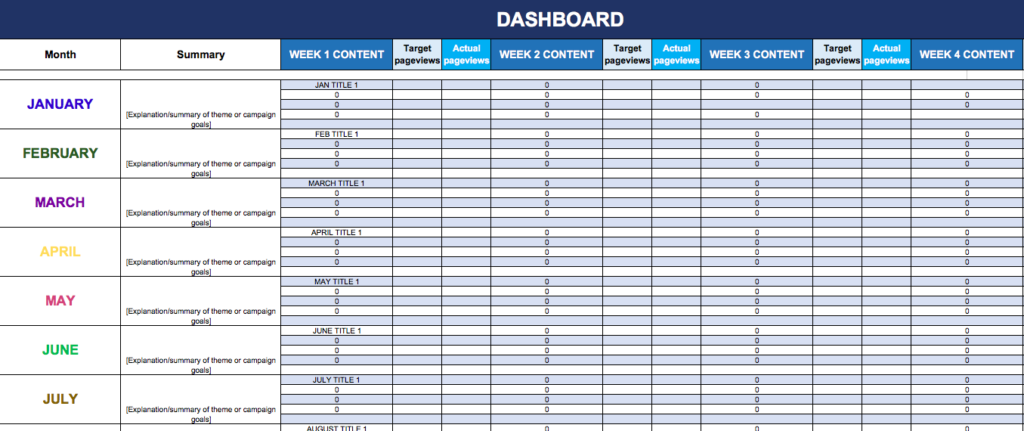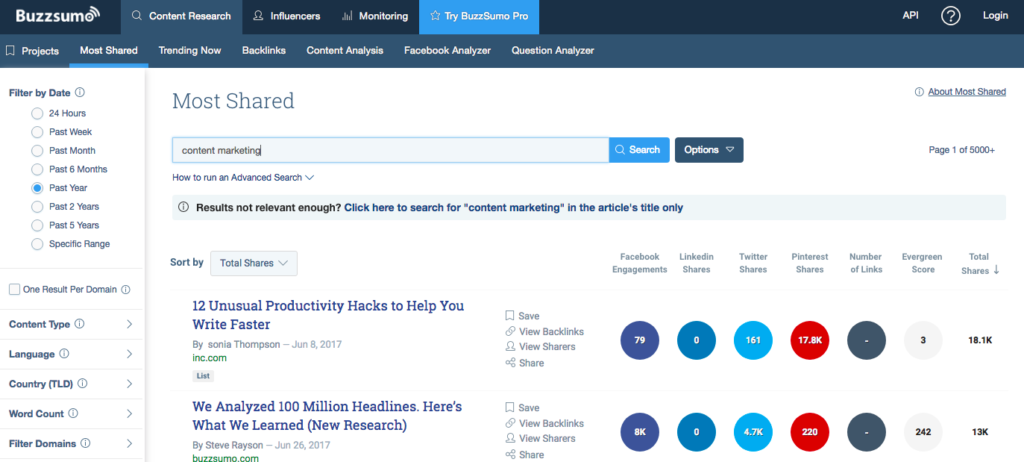Table of Contents
Last Updated on April 23, 2019 by admin
It’s fascinating how often advertising and marketing professionals (and content marketers) are referred to as “creatives.” It’s no doubt that content marketers need to have a creative side to craft engaging content. But engaging content is not the only ingredient for an effective content marketing program. A data-driven content marketing strategy can yield high-impact results.
Data-driven marketing is crucial to success in a hyper-competitive global economy. According to Onboard Informatics, 53% of businesses believe data makes them more consumer-centric and 88% use third-party data to get a better understanding of their customers. Data gives us an accurate picture of our target market, and by utilizing these findings, we can create even better content marketing strategy that drives new business.
What is Data-Driven Content Marketing?
Data-driven content marketing can be defined as the utilization of statistics, surveys, market research and public data to inform and create a content strategy. This data can provide insights into current trends dominating the market and opportunities that may exist in the future. It can also help you determine market segments and understand your audience within certain parameters such as location, age, income, education, content consumption habits, preferences and more.
A data-driven approach also looks at your existing analytics to discover which of your current content and tactics are resonating with your target audience. Metrics like most-viewed pages and top referrers can identify the most popular and socially shared content on your site. This information can feed your content creation moving forward and help you tweak where needed. The best content marketers think like data scientists in order to create valuable and insightful content and distribution strategies that are based on facts rather than assumptions.
5 Steps to Create an Actionable, Data-Driven Content Marketing Strategy
1) Look at the Data, Befriend the Data
Step one is getting down and dirty with Google Analytics. If you already have some content on your site (blogs, ebooks, white papers), take a look at how those have performed. Look at your top pages and top posts as well as where people are spending the most time on your site. These metrics contain clues as to which topics and types of content your audience prefers.
If you’re new to content marketing and don’t have much historical data to look at, you can gather information in other ways. Consider sending a brief survey as part of your next e-newsletter. Building audience personas can also be a useful exercise in figuring out exactly what your target market wants to know – and where they go to look for that information. If you have the budget, also consider commissioning market research to help build your personas and gather other valuable insights about your market. The more data and facts you use you inform your content strategy, the greater your chances of success.
Some other information-gathering activities for this stage include:
- Competitor analysis: Browse around your competitors’ websites and blogs to see which topics their covering, how they’re promoting content, and which media types they use. Take a look at their social channels to see where they’re getting the most engagement.
- Keyword research: There are plenty of tools (Moz, SEMrush, etc.) available to help you build a solid keyword strategy. Figure out your core keywords (those that best describe your product/service) and expand into long-tail keywords as well. Use a keyword demand tool like Google’s Keyword Planner to see what people are searching for and make sure your keywords include all major variations.
- Trending topics: It can also be helpful to see what related topics are trending on the web. Tap Google Trends and Twitter trends to see what is trending and what people are searching for.
2) Map Out Your Content Strategy
Next, you’ll want to start mapping out a content plan that resonates with your business objectives and target audience. A good place to start here is by building out a content calendar (free template here). This provides the framework for your strategy by allowing you to plan out your topics and themes by month or even by week. You’ll have a solid foundation for figuring out those themes from the information you put together in step one. Be sure to specify not only topics/titles, but also media types and distribution channels that are best-suited for your audience. This will help your content creation team stay organized and on task.
Don’t forget about your distribution and amplification plan. A data-driven content marketing strategy informs content creation and promotion. You’ll want to put some thought into where your content will be best-received. In some cases, social channels are an excellent way to get your content in front of the right eyes. In that case, you may want to start by mapping your content calendar to a social media dashboard (free template here) that can keep your content amplification team organized and synced up with the rest of the team.
3) Determine Effective Content Formats
Deciding which format in which to create content is a critical consideration. Is your audience more inclined to read through a white paper or peruse an infographic? Are they more engaged with video than blog posts? The answer will depend upon data you uncover during step #1and it may require some testing and iterations. According to Animoto, 4 times as many consumers prefer to watch a video about a product than to read about it. However, the right format can depend on a variety of factors, including demographics and industry. When in doubt, rely on the data. Check and double check Google Analytics. Also consider using a tool like BuzzSumo, which provides the most-shared content for a set time period. See which media types are resonating there and mimic where you can.
If you don’t have a ton of historical data across a variety of content formats, you can use industry averages and benchmarks as a kicking off point. For example, Curata’s marketing team has found that long-form blog posts, on average, generate 8X more page views, 3X more social shares, and 9X more leads than short-form posts. Tip: go long and whittle down after you collect enough data to see what length is just-right for your unique audience.
4) Hone Your Content Distribution Strategy
While you’ve set the framework for content distribution in step #2, you’ll want to iterate on that and add the final touches. Also remember that content distribution isn’t just about where, but also about when you promote your content online. Once you determine where your target customers spend time online, be sure you know when they’re spending time there as well. For example, a recent study identified that morning Facebook posts perform 39.7% better than afternoon posts. Google Analytics, Hootsuite, and SproutSocial are a few tools that can help you determine the best time to post on social media for your business.
Cadence is an important consideration here, too. In some cases, your audience may prefer to consume as much content as you can toss in front of them – via blogs, social posts, emails, etc. In most cases, however, you’ll need to fine-tune based on testing.
It can be helpful to start with some output goals. Maybe your target is 4 blog posts per month (1 per week). Additionally, you’ll send subscribers an e-newsletter at the end of the month that links to the published posts in case they missed any. After a few months, you may want to do an a/b split test where one group gets one e-newsletter per month and the other group gets one e-newsletter every two months. Obviously, you’ll need to test that for several months to get a good sample size of results. After the test, you may find higher open rates and click-thru rates at a lower frequency. Or you may not! Test, test, then test some more.
5) Analyze Results
Effective content marketing is about testing and tweaking and testing more. It’s an ongoing effort, not a set-it-and-forget-it endeavor. An important part of data-driven content marketing strategy is using tools like Google Analytics to measure the performance of your content. Also get plugged in with your social analytics, whether it’s directly through LinkedIn, Facebook, and Twitter or via a third-party dashboard like SproutSocial. Checking success metrics regularly such as traffic sources, number of visitors, visitor engagement, page views, average time spent on site, conversions, likes, shares, retweets, and mentions is important to identify the areas that are working well and the gaps that need to be filled.
Is a particular piece of content outperforming or underperforming? Did your customers complete a desired action such as downloading an eBook or signing up for a newsletter after reading your content? If not, how can you pivot to compel the right action from your audience? Look back at your content marketing goals to determine where you’re meeting and exceeding expectations – and where you’re falling short. Track your progress over time and regularly review to make the necessary improvements in your content marketing strategy.
Turning Insights Into Action
A data-driven content marketing approach typically involves analyzing existing findings and then turning those insights into action. It’s all about transforming KPIs, metrics, and benchmarks into a fact-based content marketing strategy that gets your story in front of the right eyes at the right time.
Data-driven content marketing is quickly becoming the standard in the era of Big Data and analytics. This trend will only continue as machine learning and AI enable faster data processing and the ability to garner deeper insights from data. The bottom line is that content marketing is no longer a guessing game; marketers that have access to analytics and metrics can use them to get the best results.








3 thoughts on “How to Develop a Data-Driven Content Marketing Strategy”
Pingback: Fintech Startup Formula: Content Growth Hacks – Google Site Search
Pingback: How Fintechs Can Engage With Content Marketing Agencies | Joanne - IM
Pingback: Essential Hotel Marketing Plan Components for Your Success